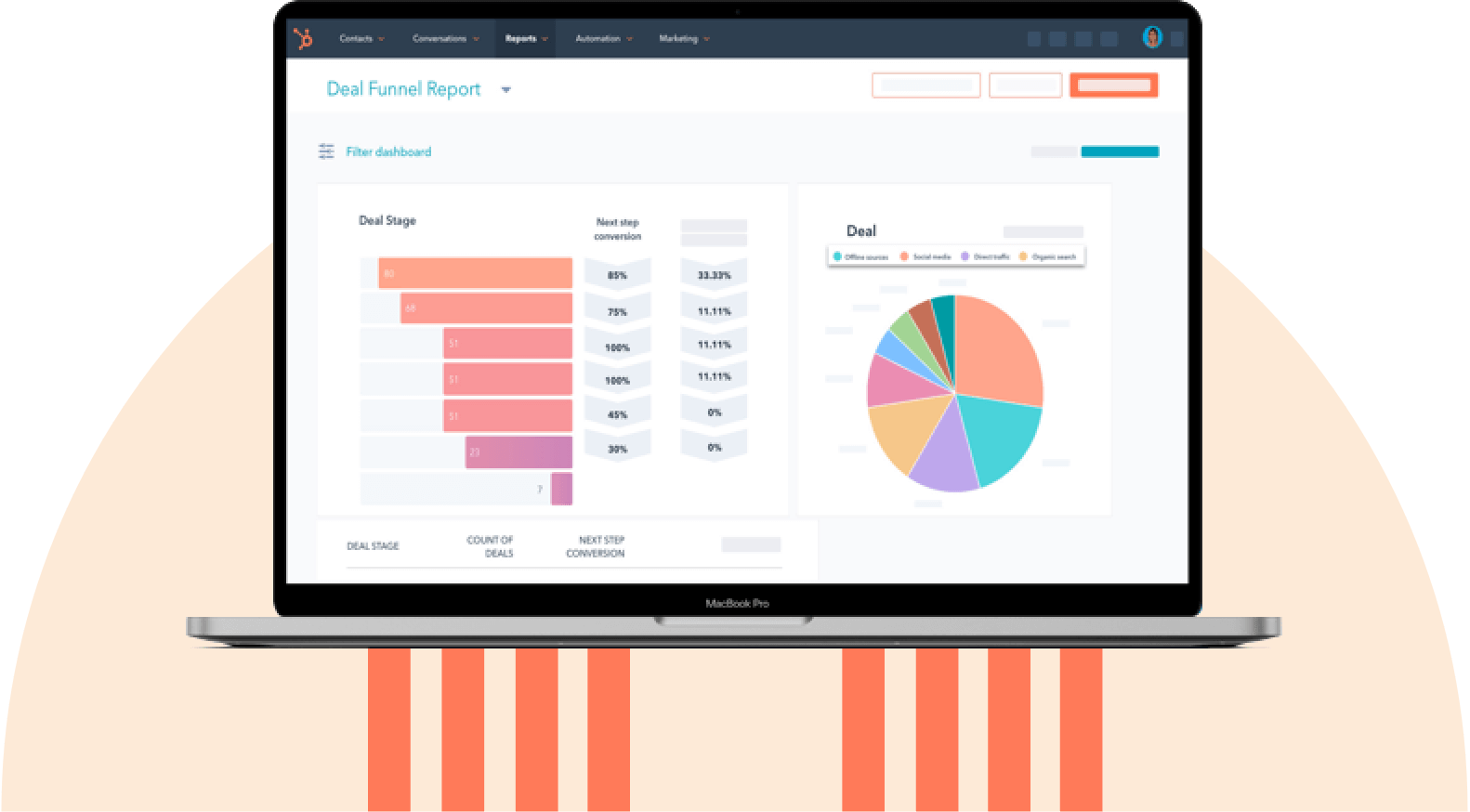Finding the right sales tools for small businesses can make the difference between chasing leads endlessly and closing deals with confidence. As someone who has worked closely with a small business owner, I know how important it is to have tools that help us work smarter.
In this article, I’ll explore what I believe are the key features to look for when choosing a sales tool for a small business. I’ll also be testing out eight of the best sales tools for small businesses and sharing my hands-on experience with each one.
I’ll guide you through the key features of these tools, break down their pricing, and share what I find most valuable about each one. My goal is to give you a clear, firsthand look at what each tool offers, so you can make a confident, informed choice for your business.
Table of Contents
- What You Should Look For in a Small Business Sales Tool
- Types of Sales Tools Every Small Business Should Invest In
- 8 Best Sales Tools for Small Businesses

HubSpot's Free CRM Software
Free CRM Software & Tools for Your Whole Team
- Sales
- Marketing
- Operations
- Customer Service
What You Should Look For in a Small Business Sales Tool
When I explore different sales tools for small businesses, here’s what I keep an eye out for.

Ease of Use
I want a tool that’s intuitive from day one. If I need to spend days figuring out how to input a lead or generate a report, it’s not the right fit. I test how easily I can navigate the interface, input data, and retrieve useful insights without a steep learning curve.
Affordability
I know budgets are tight when running or managing a small business. I evaluate whether the tool gives me solid value for its price. I also check for flexible pricing plans that can scale as my business grows, without locking me into costly contracts.
Integrations
I don’t want to waste time juggling between too many disconnected apps. That’s why I look at how well each tool integrates with platforms I already use. I check whether the tool integrates with the email platform I am using, etc. A good sales tool should make my workflow smoother, not more complicated.
Mobile Accessibility
I often find myself needing to check in on leads or deals when I’m away from my desk. I see how well each tool works on mobile devices and whether I can perform basic actions (such as updating a lead or viewing sales dashboards) on the go.
Reporting and Insights
I want more than just raw data — I want clear, actionable insights. I explore how each tool helps me visualize my pipeline, track performance, and forecast revenue. A strong reporting feature should help me make smarter, faster decisions.
Customer Support
When something goes wrong, I don’t want to be left hanging. I test how responsive and helpful the tool’s customer support is, whether through live chat, email, or an online knowledge base. Reliable support is a must-have for me.
Customization and Automations
My business has unique processes, and I want a tool that can adapt to how I work. I check how much I can customize things like deal stages, data fields, and reports to fit my specific workflow. Then I should have the ability to create automations that handle repetitive tasks for me.
As a small business owner, I want to spend less time on manual work and more time closing deals. The more I can streamline my sales process with smart automations, the smoother my day-to-day work will be.
Types of Sales Tools Every Small Business Should Invest In
- CRM
- Documents Tool
- Invoicing Software
- Inventory and Order Management Software
- Survey Tool
- Meetings App
- Email Management Tool
Most SMB owners are short on time, money, and manpower. Anything that helps them work faster and smarter has a dramatic ability on their bottom line (and stress levels).
If you run a small business, here are the seven tools that will dramatically upgrade your productivity and results.
CRM
As a small business owner, I need one place where I can keep track of every deal, contact, and conversation without losing my mind. That’s why a CRM is essential for me. It stores all the details about my contacts — their email, phone number, LinkedIn profile, and website — and automatically logs every interaction I have with them.
I can instantly see when we last talked, how we connected (phone or email), what we discussed, whether they’ve bought from me before, how often they visit my site, which pages they checked out, and which emails they’ve opened and clicked.
I don’t have to manually track any of it. It just happens.
Bottom line: If I’m choosing one tool to keep everything organized, it’s HubSpot CRM.
Documents Tool
I want to make it as easy as possible to send proposals, close deals, and get paid. That’s why having a tool to send and collect electronic signatures is a no-brainer for me. It lets me send contracts and proposals quickly, and my customers can review and sign them in minutes — no printing or scanning needed.
Faster signatures mean faster payments. HubSpot makes this even smoother by integrating with tools such as PandaDoc, so I can automate the process and keep the cash flow moving.
Invoicing Software
Reliable invoicing software helps small businesses get paid faster and manage cash flow more efficiently. With the right tool, you can quickly create and send professional invoices, track payments, and automate follow-ups for overdue accounts.
I like to look for the following key features:
- Customizable templates. Design invoices that reflect your brand with logos, colors, and personalized messages.
- Automatic payment reminders. Set up automated emails to gently nudge clients about upcoming or overdue payments.
- Online payment integration. Let customers pay directly from the invoice using credit cards, bank transfers, or digital wallets.
- Payment tracking and reporting. Monitor which invoices have been paid, which are outstanding, and generate reports to understand your revenue trends.
If you bill by the hour, I recommend choosing invoicing software that lets you easily add tracked time and expenses directly to your invoices.
Inventory and Order Management Software
If you are in a business that sells physical products, having a reliable inventory and order management system is a must for staying organized. It helps in keeping track of stock levels, purchase and sales orders, and warehouse details all in one place.
The most essential features I look for in an inventory and order management system are:
- Barcode scanning. To quickly check stock levels with a simple scan.
- Reorder alerts. Notification when inventory is running low, to avoid the risk of selling out unexpectedly.
- Reporting. To see which products are the top sellers, the total value of the inventory, and to track sales performance by week, month, or quarter.
I’ve found Xero and inFlow to be excellent choices for small business inventory management.
Survey Tool
Successful business owners have one thing in common: They’re passionate about understanding their customers better. They are also determined to identify their most satisfied clients to drive referrals and encourage repeat business.
And by spotting dissatisfied customers early, they step in and resolve issues before negative reviews surface. The more insight you have into your audience, the easier it becomes to meet their needs and market effectively.
A user-friendly platform such as SurveyMonkey (which integrates with HubSpot) makes it simple to create polished surveys — no technical expertise required. I suggest sending a quick survey after a purchase to gather feedback on the experience.
Small business owners can also use surveys to engage prospects, leads, or even your own team.
Meetings App
When you’re lining up meetings with clients, suppliers, partners, or even with people in your internal team, a scheduling app can shave valuable minutes off your day. It creates a shareable view of your availability, so others can book a slot that works for both of you.
Once a meeting is booked, it syncs straight to your calendar, no back-and-forth required. I recommend trying HubSpot’s Free Meetings Scheduler.
Email Management Tool
Email remains one of the most powerful assets for any seller. If your inbox doesn’t have tools that show when someone opened your message or clicked a link, you’re leaving actionable insights on the table.
Timing matters! I aim to follow up while I’m still top of mind. It’s far easier to get a response when your prospect just engaged with your email a few hours ago.
Maybe you want your message to hit someone’s inbox first thing in the morning, but you’ll be busy at that hour. No worries! Just schedule it ahead of time. My last recommendation is to set follow-up reminders if they haven’t replied, so nothing slips through the cracks.
Check out HubSpot’s email tools.

HubSpot's Free CRM Software
Free CRM Software & Tools for Your Whole Team
- Sales
- Marketing
- Operations
- Customer Service
8 Best Sales Tools for Small Businesses
1. HubSpot Sales Hub
HubSpot offers a comprehensive suite of tools designed to meet nearly every digital need for small businesses. Beyond its free CRM, it includes features like live chat, an AI-powered content writer, and a website builder. Its products are organized into dedicated hubs for sales, marketing, customer service, content management, operations, and more.
For this article, I will focus specifically on the features of Sales Hub.

Key Features of Sales Hub
Sales Automation Tools Sequences
This feature is designed to boost productivity. It streamlines lead assignment, follow-up tasks, and other repetitive actions using automated workflows and sequences.
I can move deals between stages, set reminders, and keep tabs on progress. This makes it easier to prioritize and close more sales.
Mobile CRM App
The HubSpot mobile app allows accessing and engaging with contact activity anytime, anywhere. Also, I can easily send professional-looking emails using pre-built templates or using HubSpot’s AI email writer.
With the business card scanner feature, I can quickly convert business cards into CRM contacts and eliminate the need for manual data input. This feature is incredibly useful for events like conferences and exhibitions, where you’re meeting numerous people and don’t have the time to manually input prospect data into your CRM.
AI Prospecting Agent
You can streamline your sales outreach with Breeze, an AI prospecting agent that helps identify high-quality leads and crafts personalized outreach within your existing workflow.
Basically, it analyzes target accounts in minutes and delivers actionable insights that would normally take days to gather manually.
I love how Breeze integrates seamlessly with HubSpot’s CRM, requiring no extra setup or training, and continuously adapts to your sales patterns to provide more relevant insights over time. This allows your team to focus on closing deals with all the prospect intelligence they need in one place.
Reporting & Analytics
HubSpot’s built-in dashboards help in monitoring campaign performance, website activity, and sales metrics. I can create custom reports to get clear insights into what’s working and where to improve. The visual pipeline tool lets me track deals at every stage of the sales process:

Equip your team with powerful insights through user-friendly analytics and reporting tools that are simple to learn.
Integrations
HubSpot connects with over 1,800 apps and tools, making it easy for me to integrate my CRM with platforms I already use such as Gmail and Zoom.

I can share a link that lets prospects book time on my calendar directly. This cuts down the back-and-forth of scheduling meetings and keeps the pipeline moving smoothly.
What I Like
For small businesses, every minute counts. With lean teams, working efficiently is essential. And that’s where I feel automation makes a real difference. HubSpot is a top choice for me for boosting productivity with its robust automation tools.
I worked for a logistics company that didn’t have the capacity to cater to companies that had a low order volume.
So, I set up the following workflow to automatically email anyone who filled out our website form but didn’t meet our minimum order requirements.

Similarly, another inbound qualification workflow was created to streamline the work.
The purpose of this workflow was to take data from our website’s form submissions and check whether the property was in the company’s TAM.

As you can see, the workflow essentially classified properties according to the monthly number of orders and then set actions and next steps accordingly (for instance, adding to list, SDR contacting them, sending out email, updating lifecycle stage, etc.).
In my experience, HubSpot makes building automations remarkably straightforward and simplifies the processes of a business.
Pricing
HubSpot offers a free CRM with core features — perfect for small businesses that are looking to explore first. Its paid plans unlock advanced tools for marketing, sales, and service that allow businesses to scale as their needs grow.

The Starter Customer Platform pricing starts from $20 per month per seat. For businesses that need a comprehensive solution covering marketing, sales, customer service, and content management, the Professional plan is a great fit.
2. Odoo
Odoo markets itself as the “real-customer centric” CRM. Odoo is a comprehensive software which has a lot of modules for different business verticals.
![]()
Key Features
Sales
The sales module is mainly related to creating quotes easily. It is designed to boost sales by suggesting add-ons, applying discounts, and using closing triggers.
Once a quote is confirmed, it automatically converts into a sales order, and relevant teams are notified in real time to keep operations moving smoothly.
Invoicing
Invoices can be generated easily from confirmed sales orders (automatically, in batches, or individually). Sales and billing are fully integrated, with flexible invoicing policies and payment terms based on confirmation or delivery. Once an invoice is sent, customers can pay online.
Odoo Invoicing also simplifies payment follow-ups with automated reminders for late or outstanding invoices, helping to streamline the billing process. Vendor bills can be managed just as easily, and checks can be printed to ensure timely supplier payments. The app connects directly to the accounting platform, with accounting entries posted in real time to the correct journals and accounts.
Accounting & Finance
Odoo automatically syncs and imports bank statements, making real-time reconciliation quick and easy. Simply validate the match between statement lines and accounting entries. The platform provides all key financial reports (balance sheets, profit and loss, aged receivables and payables, and tax reports) — all of which are dynamic.

Reports can be filtered, annotated, customized, and compared across periods. The Accounting app also supports multi-currency and multi-company environments, allowing for inter-company transfers and consolidated reporting across subsidiaries.
What I Like
I like Odoo CRM because it gives the option to manage multiple sales teams and pipelines without things getting messy. I can create opportunities by hand, import them, or even have them pop in automatically from emails or website forms. Also, each salesperson gets their own dashboard, so they can stay focused on the deals that matter and close faster.
I really like how Odoo offers the flexibility to add additional modules as needed, including:
- Inventory & Purchasing
- Manufacturing, PLM, Maintenance, & Quality
- Website & ecommerce
- Events
A small business can easily integrate these modules at any time, depending on their evolving needs and requirements.
Pricing
Odoo’s beginner plan which allows one app is free of cost. The standard cost per user is $31.10 per month.
![]()
The custom plan is suitable for enterprises who want to deploy on their own cloud, instead of using the Odoo online services.
3. Pipedrive
Pipedrive’s AI-powered CRM centralizes, organizes, and prioritizes leads to simplify follow-ups and boost sales. Its AI Sales Assistant alerts reps about inactive deals, helping them stay on track and close more opportunities.
Key Features
Contact Management
Pipedrive centralizes contact details, including custom fields, deal history, emails, tasks, and notes in one view. It syncs with your email to automatically log conversations and track updates, keeping your team informed with the latest context.
Workflow Automation
This feature allows automating tasks such as email sending, task creation, lead assignments, and field updates with customizable workflows and triggers.
Workflows can be set up to trigger when deals or contacts are updated, such as sending an email, creating a task, updating fields, or assigning leads to the relevant team member.
Sales Reporting & Insights
Pipedrive provides customizable sales dashboards and AI-powered reports to track deal progress, conversion rates, and team performance. Detailed reports can be created without needing data analysis skills. The platform also offers smart suggestions for qualifying leads and deals, making it easy to stay on top of your sales process.
Deal Tracking
The tool has customizable, drag-and-drop pipelines that reflect your sales process, complete with deal probabilities and activity tracking. Multiple pipelines can be designed to fit different workflows, such as new sales, renewals, or upselling opportunities.
What I Like
The tool is developed in such a way that it seems effortless to modify deal details, rename pipelines, and adjust deal views in Pipedrive. Creating custom fields is also quick and straightforward.

I’m also a fan of Pipedrive’s Sales Inbox and the features that come along with it. The “send later,” AI-assisted email writing, and integrated meeting scheduler features make communication feel very efficient.
![]()
One area where I think Pipedrive falls short is in its lack of attribution features and the ability to build detailed customer journeys, which are available in HubSpot.
Pricing
Pipedrive provides five different plans that are catered towards different businesses.
![]()
The basic plan starts at $24/user per month and the pricing goes all the way up to $129/user per month.

HubSpot's Free CRM Software
Free CRM Software & Tools for Your Whole Team
- Sales
- Marketing
- Operations
- Customer Service
4. ClickUp
Although ClickUp excels mainly in project management and team collaboration, they have started pitching themselves as a sales tool that can be used for customer onboarding, lead tracking, and deal collaboration.
Key Features
Automation
With automations, prospects are able to advance through the pipeline easily. This helps automatically delegate tasks as deals progress, send real-time updates when customers take action, and adjust priorities to keep the team focused on the most critical opportunities.
Custom Statuses
With this feature, status labels can be tailored to clearly show where each account stands in the process. Start your setup with pre-made templates or create and save custom ones for future use.
Docs
ClickUp allows drafting documents, knowledge bases, workflows, and proposals. This gives the ability to enhance content with advanced text formatting, exchanging feedback through comments, and also working alongside the team easily.
Column Calculations
Perform quick calculations on numeric fields directly in List view to instantly sum contract amounts, estimate closing costs, revenue, and other key figures.
What I Like
Once tasks are assigned, I can add comments and set action items. I think this is especially useful for sales teams aiming to stay organized and focused on their priorities.

I can easily break large tasks into smaller, manageable subtasks, which gives everyone on the team a clear understanding of what needs to be done next. It keeps the workflow structured and makes it simple to track progress without things slipping through the cracks.

This way I can easily oversee the sales team, monitor prospects, and stay one step ahead so no opportunity slips by. The best part is that ClickUp allows me to visualize my entire pipeline on a List, Kanban board, Table, or one of ClickUp’s 10+ flexible views.
Pricing
The basic plan of ClickUp is free. For small businesses, the best deal per month is $10 per user and $19 per month for mid-sized businesses.
![]()
For large enterprises, pricing is customized based on your specific needs. You won’t find set rates listed on the website. Instead, you’ll need to contact the sales team for a tailored quote.
5. Zoho
Zoho is a budget-friendly CRM solution for micro businesses. It is a tool to simplify the sales process and to equip teams with everything required to generate more leads, speed up deal closures, and track sales performance effectively.
Key Features
Sales Enablement
This feature is mainly for creating price quotes quickly, sharing sales scripts, and giving customers, vendors, and partners controlled access to view, update, or add information directly through the CRM.
Predictive Sales
Zia, the built-in AI assistant in Zoho CRM, helps you stay in control of your sales data. Zia pulls up key information, jots down notes, forecasts deal outcomes, spots irregularities, and automates routine tasks. Think of it as having an intelligent teammate who ensures you never miss a beat.
Partner Portals
Partnerships are an important part of sales, especially in B2B where partners pitch your product in their respective verticals. This feature in Zoho gives partners access to create and nurture leads, manage inventory, and view the contacts.
Calendar
The tool provides the option to set priority meetings with customizable reminders and turn them into recurring events with a simple click. In essence, managing all schedules in one place is pretty straightforward with Zoho.
What I Like
I particularly like the voice-enabled assistant inside Zoho CRM. They’ve given Zia a distinct personality with a friendly female voice. It makes interacting with her feel more natural. From jotting down notes to quickly crunching sales numbers, she handles it smoothly and efficiently.
Zoho has built a strong reputation for seamlessly managing the financial side of business operations. If I needed a tool to generate quotes, invoices, and orders (all while keeping inventory, shipping, and subscription details within easy reach) Zoho CRM would be my top choice.
Pricing
Zoho provides a Standard plan that starts at $20 per month/user.

However, if your team grows or you need access to more advanced features, you’ll have to upgrade to the Enterprise or Ultimate plan.
6. MyAIFrontDesk
For small teams wearing many hats, keeping up with client calls and appointments can be challenging. MyAIFrontDesk serves as a smart virtual receptionist designed for small businesses and startups.
It uses conversational AI to assist sales teams with answering incoming calls, booking meetings, and addressing customer questions.
Key Features
Autopilot CRM
This feature helps in streamlining lead management by sorting contacts, recording important details, and keeping your CRM updated. At the same time, the AI receptionist takes care of the incoming calls.
Unlimited Parallel Calls
Let’s assume that two different people simultaneously call your office after working hours and inquire about the details of your product. The AI receptionist can instantly provide answers. It gives callers fast, helpful support even when your team is unavailable.
Texting Workflows
This feature allows you to send personalized links via text during a call. If a caller wants to book a meeting, for example, the receptionist can instantly text them your scheduling link (such as Calendly). Calendly is one of the most popular options for this, but there are some good Calendly alternatives that you can also explore.
What I Like
I like how the tool takes care of call management, freeing up sales teams to concentrate on higher-value tasks like nurturing leads and strengthening customer relationships.
I think having such a tool in your arsenal means fewer missed leads, double bookings, or delayed conversations. As the system interacts directly with callers, it automatically shares that information with your customers. In the initial phase, you need to provide details about your business and services.
Pricing
The Starter plan is priced at $65 per month and includes over 100 premium voice options.
![]()
The Pro plan, at $97 per month, unlocks advanced features, including access to over 6,000 integrations.
7. Freshworks CRM
Freshworks’ CRM solution, Freshsales, promotes itself as a tool designed to streamline sales processes and boost revenue through enhanced productivity, collaboration, and valuable insights.
Key Features
AI-powered Assistance and Insights
Freddy AI enhances productivity by providing 24/7 assistance, identifying top leads and deals, offering valuable insights, and even drafting emails. Their AI is meant to allow businesses to stay ahead of the curve.
Pipeline Management
Freshsales lets you manage multiple pipelines for different teams, with clear stages to track deals easily. Create a product catalog and link items with deals to automatically calculate values with precision.
Set sales goals with timelines and monitor progress to stay on target. Forecast sales with committed deals and best-case estimates for better planning. The system also flags rotten deals so you can prioritize those that need action.
Analytics
The Analytics feature lets you track team performance across regions and access key metrics with ease. Built-in reports allow for quick data visualization, progress tracking, and trend identification.
Attribution tracking helps you see which channels and interactions drive conversions. You can also follow how deals convert over time to optimize your process. If you need more control, the custom reports option allows building from scratch by choosing the metrics, charts, and widgets that matter most to you.
What I Like
The best thing that I like about Freshworks is that it has a clean, intuitive interface with powerful CRM features. Basically I hit the ground running with minimal setup and no steep learning curve.

I also like how they have made sales into a separate product, focusing only on essential features to keep the CRM clean and efficient. The Analytics section includes a convenient Favorites tab, where I can easily save and access the most relevant reports.
Pricing
The Growth plan is priced at $11 per month for each user and includes basic workflows, Freshworks Marketplace, and the mobile app.

The Pro plan starts at $47 per month. It includes everything in growth plus some advanced features, such as territory management, deal insights by Freddy AI, etc. The Enterprise plan starts at $71 per month for each user and has custom modules, forecasting insights, sandbox, and more.
8. Copper
Copper CRM is a Google Workspace-native CRM that is designed to simplify tracking leads, managing contacts, and organizing sales activities without leaving your Google apps.
Key Features
Mobile App
The mobile app lets you stay on top of your work from anywhere. It helps you manage leads and stay organized by giving you instant access to contact details and activity history on the move. Calls and texts are automatically recorded, ensuring every interaction is captured and your records stay current.
Contact Management
Like most other CRMs, Copper also centralizes all your communication (emails, calls, documents, and notes) so you have a complete view of every connection.
It allows capturing leads directly from your website using customizable forms, instantly creating contacts by snapping a photo of a business card, and getting automatic contact suggestions from Gmail and Google Calendar through the Chrome extension.
Context
It gives teams a unified view of customer data, pulling in interactions from multiple channels. Summaries can be customized to emphasize key details, while an interactive timeline helps track real-time activity.
Highlight cards show recent actions, sales sequences, and contact history for quick insights. The system also auto-enriches profiles with public and social data to keep records current.
What I Like
As I usually work a lot in Google Workspace, this CRM fits right in. Copper connects effortlessly with Gmail, Calendar, and Drive. It lets me add leads, track emails, locate files, and handle tasks without leaving Google’s ecosystem.
It’s the CRM that’s Google-backed, recognized as a Chrome Enterprise Partner, and officially recommended for Google Workspace.
Pricing
The Starter plan is priced at $11 per month for each user. The basic plan starts at $29 per month per user and includes task automation, project management, and contact enrichment.

The Pro plan starts at $69 per month and has a 15,000 contact limit. The business plan starts at $134 per month and has unlimited contacts, premium support, and also the option to create custom reports.
It’s worth noting that the CRM comes at a higher price point, and many users have reported less-than-ideal customer support. Adjusting or reducing user licenses isn’t straightforward either (you can only decrease them by contacting support at least 30 days before your renewal), which I think adds an extra layer of hassle.
Improve your small business operations with the right tools.
The sales tools your small business needs in its tech stack depend on your business type, goals, and team. I have highlighted what I see are the essentials for a well-functioning business that takes advantage of software and AI to ease its operations.
I especially recommend a robust CRM that will allow you to manage your customer interactions and that can integrate with other tools to help manage your pipeline, close deals, and keep your customers happy.

HubSpot's Free CRM Software
Free CRM Software & Tools for Your Whole Team
- Sales
- Marketing
- Operations
- Customer Service





-Mar-15-2022-03-47-44-05-AM.png)


